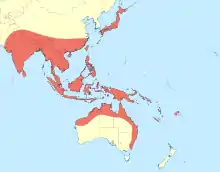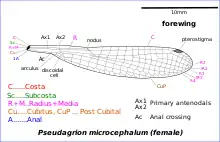| Blue riverdamsel | |
|---|---|
 | |
| Male | |
 | |
| Female | |
| Scientific classification | |
| Domain: | Eukaryota |
| Kingdom: | Animalia |
| Phylum: | Arthropoda |
| Class: | Insecta |
| Order: | Odonata |
| Suborder: | Zygoptera |
| Family: | Coenagrionidae |
| Genus: | Pseudagrion |
| Species: | P. microcephalum |
| Binomial name | |
| Pseudagrion microcephalum | |
 | |
The blue riverdamsel, Pseudagrion microcephalum[3][1] is a common species of damselfly in the family Coenagrionidae.[4][5] It is also known as the blue sprite[6] and blue grass dart.[7]
Distribution
This species can be found in the Australian states of New South Wales, Northern Territory, Queensland, Victoria and Western Australia. It can also be found in Africa: southern Nigeria and Asia: Bangladesh, China, Guangxi, Hong Kong, Hainan, Indonesia, India, Japan, Sri Lanka, Myanmar, Malaysia, Philippines, Peninsular Malaysia, Singapore, Thailand, Taiwan, and Viet Nam.[1][8][9]
Description
It is a medium-sized damselfly with pale blue eyes, dark on top. They grow to 38mm in length. Its thorax is azure blue with black, broad dorsal stripes and narrow humeral stripes. Abdominal segments 1 and 2 are blue with black marks on the dorsum. Mark on segment 2 looks like a chalice or thistle-head. Segments 3 to 7 are black on dorsum and blue on the sides. Segments 8 and 9 are blue; 8 with a thick and 9 with a thin black apical annules. Segment 10 is black on dorsum and blue on the sides. Superior anal appendages are of the same length of segment 10; black and divided at the apices.[10]
Eyes and thorax of the female is bluish green, suffused with orange, marked as in the male; but black is replaced by orange. Color of the abdomen is similar to the male; but paler. Segments 8 and 9 are also black with fine apical blue rings. Segment 10 is pale blue.[10]
_male.%252C_%E0%B4%A8%E0%B4%BE%E0%B4%9F%E0%B5%8D%E0%B4%9F%E0%B5%81%E0%B4%AA%E0%B5%8D%E0%B4%AA%E0%B5%82%E0%B4%A4%E0%B5%8D%E0%B4%A4%E0%B4%BE%E0%B4%B2%E0%B4%BF._(26148144539).jpg.webp) Male
Male Male from above
Male from above Young male
Young male_female.%252C_%E0%B4%A8%E0%B4%BE%E0%B4%9F%E0%B5%8D%E0%B4%9F%E0%B5%81%E0%B4%AA%E0%B5%8D%E0%B4%AA%E0%B5%82%E0%B4%A4%E0%B5%8D%E0%B4%A4%E0%B4%BE%E0%B4%B2%E0%B4%BF._(25267244818).jpg.webp) Female
Female_Mating_(19652922464).jpg.webp) Tandem pair
Tandem pair._(25346618558).jpg.webp) Mating pair
Mating pair Illustration of Pseudagrion wing
Illustration of Pseudagrion wing.jpg.webp) Photo of male wings
Photo of male wings
Pseudagrion microcephalum looks similar to the common bluetail and the eastern billabongfly. The female is blue-grey to grey-green in colour.[4]
Habitat
This species can easily be found near running water or still water. They usually rest on the plants either in the middle of ponds or at the water edges. It breeds in ponds, lakes and streams. It is entirely a species of the plains, being replaced by Pseudagrion malabaricum in the neighboring hills of Western Ghats of India and Sri Lanka, and by Pseudagrion australasiae to the north-east of India and Burma.[10][11][12][6][7]
See also
References
- 1 2 3 Dow, R.A.; Wilson, K.D.P. (2017). "Pseudagrion microcephalum". IUCN Red List of Threatened Species. 2017: e.T167199A83376119. doi:10.2305/IUCN.UK.2017-1.RLTS.T167199A83376119.en. Retrieved 20 November 2021.
- ↑ Rambur, Jules (1842). Histoire naturelle des insectes. Névroptères (in French). Paris: Librairie Encyclopédique de Roret. pp. 534 [259] – via Gallica.
- ↑ Paulson, D.; Schorr, M.; Abbott, J.; Bota-Sierra, C.; Deliry, C.; Dijkstra, K.-D.; Lozano, F. (2023). "World Odonata List". OdonataCentral, University of Alabama. Retrieved 14 Mar 2023.
- 1 2 Theischinger, G; Hawking, J (2006). The Complete Field Guide to Dragonflies of Australia. Collingwood Vic.: CSIRO Publishing. p. 84. ISBN 978 0 64309 073 6.
- ↑ Blue riverdamsel - Pseudagrion microcephalum
- 1 2 "Pseudagrion microcephalum Rambur, 1842". India Biodiversity Portal. Retrieved 2017-03-07.
- 1 2 "Pseudagrion microcephalum Rambur, 1842". Odonata of India, v. 1.00. Indian Foundation for Butterflies. Retrieved 2017-03-07.
- ↑ "Australian Faunal Directory". Archived from the original on 2011-04-02. Retrieved 2009-09-04.
- ↑ K.A., Subramanian; K.G., Emiliyamma; R., Babu; C., Radhakrishnan; S.S., Talmale (2018). Atlas of Odonata (Insecta) of the Western Ghats, India. Zoological Survey of India. pp. 177–178. ISBN 9788181714954.
- 1 2 3 C FC Lt. Fraser (1933). The Fauna of British India, including Ceylon and Burma, Odonata Vol. I. Red Lion Court, Fleet Street, London: Taylor and Francis. pp. 278–290.
- ↑ C FC Lt. Fraser (1924). A Survey of the Odonate (Dragonfly) Fauna of Western India and Descriptions of Thirty New Species (PDF). p. 497.
- ↑ Subramanian, K. A. (2005). Dragonflies and Damselflies of Peninsular India - A Field Guide.
External links
![]() Data related to Pseudagrion microcephalum at Wikispecies
Data related to Pseudagrion microcephalum at Wikispecies
![]() Media related to Pseudagrion microcephalum at Wikimedia Commons
Media related to Pseudagrion microcephalum at Wikimedia Commons
